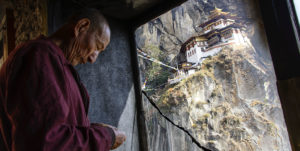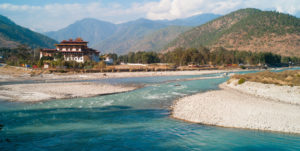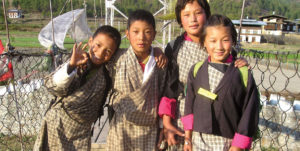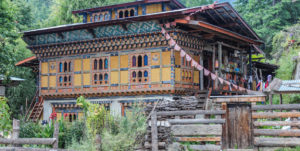Immerse yourself in the ancient way of life that still thrives in Bhutan today on this 11 day Hidden Kingdom tour. Bhutan’s capital Thimphu offers many incredible sites to explore including the Memorial Chorten and the ancient Tango Monastery. Continue on to Punakha, the former capital, offering many highlights including its incredible Dzong and Chimi Lhakhang, also known as the ‘Temple of the Divine Madman’. As you drive further east you will pass by many farms and hills decorated with prayer flags, over high mountain passes and through small villages, temperate forests and emerald valleys. Discover the Phobjikha Valley, a beautiful Alpine wetland and winter home to the Black-Necked Cranes and Trongsa, the birthplace of the monarchy before reaching Bhutan’s spiritual heartland, the central Bumthang valley. Visit the ancient monasteries, temples and many sacred sites of Bumthang before returning eastwards towards beautiful Paro. Visit Kyichu Temple, Drukgyel Dzong, and the incredible Taktsang “Tigers Nest” Monastery. Along the way you may be able to make offerings or worship in one of the many temples or monasteries, try your hand at our national sport Archery, and spend time enjoying the spa and massage treatments available at your accommodations.
If you would like to spend less time driving during this tour, we can incorporate a domestic flight from Bumthang back to Paro (subject to availability). Please contact us for details.
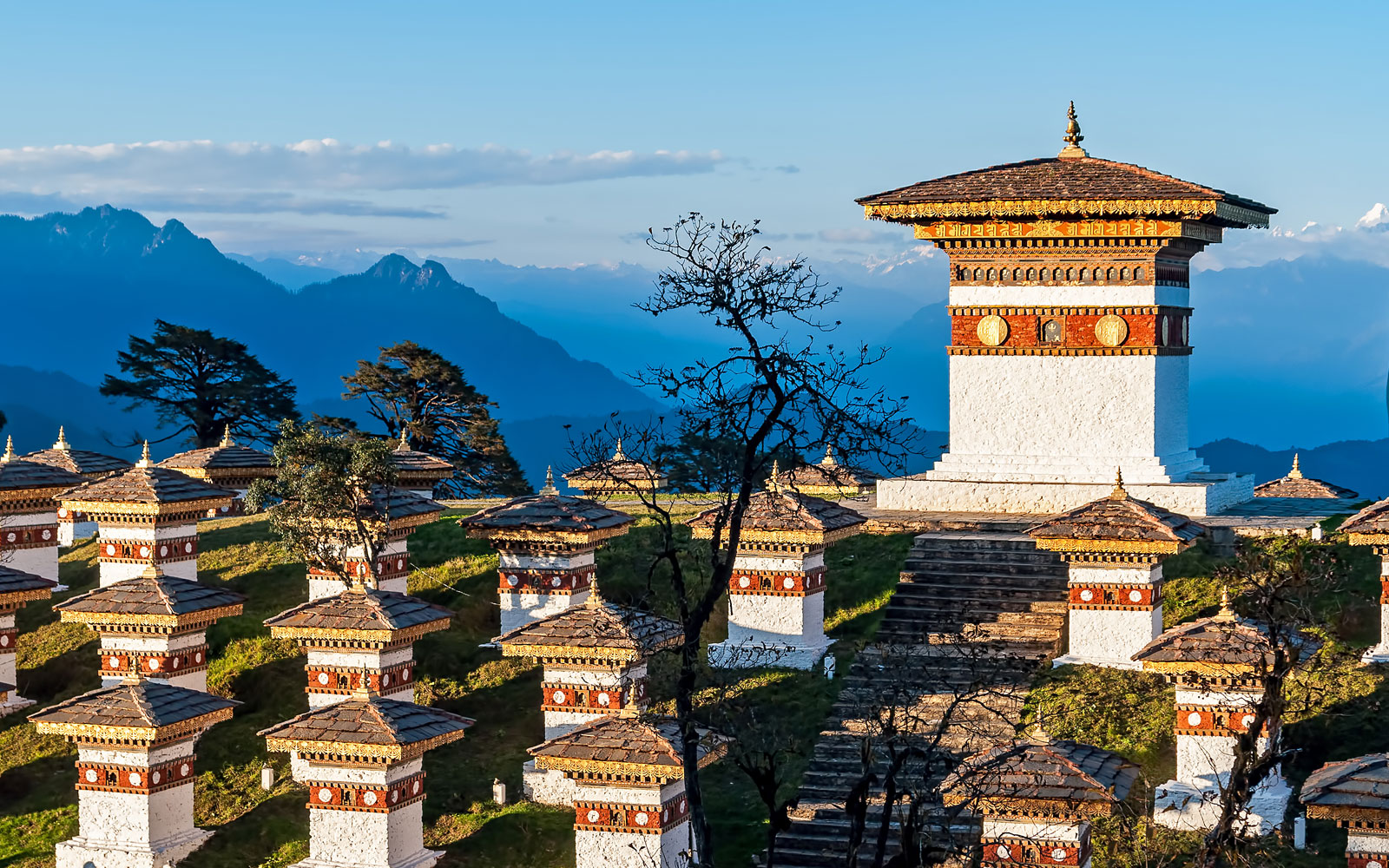
DETAILED SUGGESTED ITINERARY:
Day 1: Arrive Paro
Fly into Paro Valley on our national carrier, Drukair. In clear weather, magnificent views of the world’s highest peaks give way to the lush green Paro valley as you land. The first gift from Bhutan will be the cool, clean fresh air as you step out of the plane – a befitting introduction to the spectacular beauty of Bhutan. The concierge of Amulet Luxury Travel Bhutan will take care of all airport formalities whilst you enjoy the comfort of the VIP airport lounge services.
After lunch visit one of the holiest temples in Bhutan, Dungtse Lhakhang (temple). Dungtse Lhakhang was built in 1421 by the famous Lama, Thangton Gyelpo (1385-1464), also known by the name of Chagzampa, ‘the builder of iron bridges’ or Drubthob, ‘the realized One’. It has three floors representing hell, earth and heaven and the paintings inside are considered to be some of the best in Bhutan.
In the afternoon explore Kyichu Lhakhang. King Songtsen Gampo built this temple in 659 AD. It is believed to be holding down the left foot of a demon whose body is so large that it covers Bhutan. This Lhakhang contains a 5 meter-high statue of Guru Rinpoche and another of Tara, who represents one of the wives of King Songtsen Gampo. It is one of the most sacred monasteries in Bhutan.
If time permits, explore Paro town, either accompanied, or on your own. Please note that your personal guide and chauffer will be at your beck and call as and when you need his/her assistance. He/she will be just a phone call away (use the phone which will be provided to you upon arrival).
Return to your hotel for dinner. Overnight in Paro.
Day 2: Drive to Thimphu, Capital City of Bhutan
Drive to Thimphu, a journey of approximately 1.5 hrs. Spend the remainder of the day on a tour exploring some of Thimphu’s many sites. These include the Memorial Chorten, built in 1974 in memory of the Third King of Bhutan His Majesty Jigme Dorji Wangchuck, who died in 1972.
Also visit Changangkha Lhakhang, one of the oldest temples in the Thimphu valley, the National Library featuring an extensive collection of Buddhist literature mostly in block-printed format, with some works several hundred years old, the School of Traditional Arts and the Folk Heritage Museum.
In the evening before dinner, stroll through the streets of Thimphu. Overnight in Thimphu.
Day 3: Thimphu
After an early breakfast drive to Tango Monastery, located about 12 kilometers north of Thimphu. The trail to Tango Monastery is a climb of 280 meters and takes about an hour. Tango Monastery was founded in the 12th century, and was rebuilt in its present form in 1688 by the 4th temporal ruler of Bhutan, Gyalse Tenzin Rabgye. It is now the residence of his young 7th reincarnation. Tango Monastery is also the only Buddhist University in Bhutan where His Eminence the 9th Khamtrul Rinpoche completed his studies in Master of Buddhist Philosophy in 2009. Currently, His Eminence Thuksey Rinpoche is in his final year in Tango University of Buddhist Studies pursuing his Master of Buddhist Philosophy.
After lunch return to your hotel for some time at leisure. In the late afternoon, visit Tashichoedzong, ‘The Fortress of the Glorious Religion’. The Dzong houses some of the Ministries, His Majesty’s Secretariat, and the Central Monk Body. Overnight in Thimphu.
Day 4: Drive to Punakha
After breakfast begin your drive to Punkaha, a distance of approximately 72 kilometres. The road climbs to Dochu La Pass, located 3,050 meters (10,000 feet) above sea level and marked by a large array of prayer flags and 108 chortens. On a clear day the pass offers a panoramic view of the Bhutan Himalayas. You will have the best chance of a view in the early morning between October and February.
Following lunch visit Punakha Dzong, built in 1637 by Shabdrung Ngawang Namgyel, the unifier of Bhutan. The Shabdrung died in 1651 while he was in meditation at Punakha Dzong, and his body is preserved in one of the Dzong’s temples. Punakha Dzong is the winter headquarters of the Central Monastic Body headed by the Je Khenpo. The Central Monastic Body shifts to Punakha for the winter and back to Thimphu for the summer. The three-storied main temple of the Dzong is a breathtaking example of traditional architecture with four intricately embossed entrance pillars crafted from cypress and decorated in gold and silver. The coronation of Ugyen Wangchuck, the First King of Bhutan, took place at Punakha Dzong in 1907.
Overnight in Punakha.
Day 5: Drive to Trongsa
Drive to Trongsa (6 hrs) over the Pele La pass (3,420m) on the Black Mountain range. Enroute visit beautiful Chendebji Chorten. The Chorten was erected in the 18th century. The imposing Trongsa Dzong can be viewed across a deep canyon to signal your approach to the town around a curving road. Trongsa is the ancestral home of Bhutan’s ruling dynasty.
Visit Trongsa Ta Dzong Museum, inaugurated by His Majesty the 5th King of Bhutan, Jigme Khesar Namgyal Wangchuck in 2008. The museum is dedicated to the monarchs of the Kingdom. It is situated strategically above the Trongsa Dzong. Built in 1652, the Ta Dzong served as the watchtower for centuries.
Continue on to visit Trongsa Dzong, the most impressive Dzong in the Kingdom. Trongsa Penlop (Governor) Chhogyel Mingyur Tempa built the Dzong in its present form in 1644. Trongsa Dzong is the ancestral home of Bhutan’s royal family. The first two hereditary kings ruled from this Dzong, and it is still a tradition that the crown prince first serves as Trongsa Penlop before ascending to the throne. Overnight at your hotel in Trongsa.
Day 6: Drive to Bumthang
After breakfast drive to the Bumthang Valley (2.5 hrs), the spiritual heartland of the country. The road winds steeply up to Yo Yutung La Pass (3,400m) before descending down through dense coniferous forest and into the valley.
After spending some time to refresh at the resort, visit the temple of Jampa (Maitreya). It is believed that it was constructed in the year 659, on the same day as Kyichu Lhakhang in Paro was built by the Tibetan King Songtsen Gampo. It is one of the 108 temples built by him throughout Tibet and the Himalayas constructed to overcome a giant demon. Jampa Lhakhang was placed on the demon’s left knee and was one of the temples built ‘to subjugate the frontiers’. The central figure in the Lhakhang is Jampa, the Buddha of the Future. From Jampa Lhakhang enjoy a short walk of about 15 minutes to Kurjey Lhakhang complex. The Kurjey site is one of the most sacred in Bhutan as Guru Rinpoche meditated here and left an imprint of his body on a rock. Both of these temples date back to the origin of Buddhism in Bhutan.
Following lunch visit Jakar Dzong. The Dzong of the white (kar) bird (Ja) is very elegant and more modest in size than other Dzongs of Bhutan. It is the administrative seat of the district and, since 1998, a Drukpa monastic community. On your return trip back to your accommodation you may wish to the small township of Jakar. Overnight in Bumthang.
Day 7: Bumthang
The day will start with a visit to a 16th century palace called Tang Ugyen Choeling, originally built by Deb Tsokye Dorji, a descendant of Dorji Lingpa. The palace complex has been turned into an eco-museum to preserve its legacy and provide a place for religious studies, research and solitude. The museum also features an excellent overview of traditional rural life in Bhutan. Then continue on to visit Mebartsho, ‘the flaming lake’. Mebartsho is located in a narrow gorge in Tang valley, which is a short drive from Jakar; and is one of the great pilgrimage sites of Bhutan. This is where Pema Lingpa found the treasures (Terma) hidden by Guru Rinpoche and thus became a terton, a ‘discoverer of religious treasures’. The lake is so-named because of an incident involving Pema Lingpa in the late 1400s. The first Terma that Pema Lingpa discovered here contained instructions to return to the lake to collect more treasures. When the local governor accused Pema Lingpa of trickery, he declared that if he were the real revealer of treasures, he could dive into the lake with a lamp, and would return with a lamp still lit. If he were a devil, he would perish. Pema Lingpa took a plunge in the lake and was gone long enough to satisfy the skeptics; but he soon emerged clutching a statue and a box of treasures, with the lamp still burning.
After lunch, your second part of the day in Bumthang will start with a visit to Tamshing Lhakhang, founded in 1501 by Terton Pema Lingpa. It contains paintings of fundamental interest for the history of painting in this region. On the lower floor is a coat of chain mail attributed to Pema Lingpa, who had knowledge of metallurgy. It weighs about 25 kilograms. The tradition says that if a person walks three times around the sanctuary wearing this coat of chain mail, a part of his/her sins will be wiped away. A short distance below Tamshing Lhakhang is a small rural-looking temple called Konchogsum Lhakhang – the source of many interesting stories. The temple is very old, probably dating back to the 6th or 7th century. However, it looks quite new as it was renovated in 1995. The small statues of the three Buddhas (past, present and future) in the sanctuary are said to have flown here straight from Khaine Lhakhang in Kurtoe in eastern Bhutan. Hence the name of this lhakhang is Konchogsum – konchog (divine being) and sum (three).
After a long day, unwind with a relaxing hot stone bath*.
Overnight in Bumthang.
*A select range of accommodations offer in-house hot stone baths. Please contact us for details.
Day 8: Drive to Phobjikha Valley (Gangtey)
Start early today for the Phobjikha Valley, approximately 6 hrs from Bumthang. Farmhouses and temples dot the landscape and you may see local farmers wearing the traditional woven bamboo hats of central Bhutan. Enjoy a picnic lunch en-route.
Phobjikha Valley is one of Bhutan’s few glacial valleys, and one of Bhutan’s most important wildlife reserves. It is one of the two chosen winter homes of black-necked cranes (November-March) migrating from the Tibetan plateau. Overnight in Phobjikha.
Day 9: Drive to Paro
After breakfast visit 17th century Gangtey Goemba (Monastery) before departing for Paro (approx 7 hrs). From Gangtey the road gradually descends into the balmy Punakha valley before climbing up over Dochu La Pass. Overnight in Paro.
Day 10: Paro (Taktsang Monastery ‘Tiger’s Nest’ Hike)
Drive to the foothill of Taktsang Monastery. There are two options available to enable you to reach Taktsang Monastery (Please note that riding pony downhill is not recommended). You can either choose to ride a pony or hike. It takes approximately one and a half hours uphill to reach the Taktsang cafeteria overlooking the magnificent Monastery perched on the side of a cliff 900 meters above the floor of the Paro valley. From here it is about another hour to a lookout point beside the monastery.
Taktsang means ‘tiger’s nest’. Guru Rinpoche is said to have flown to the site of the monastery on the back of a tigress. He then meditated in a cave for three months and converted the Paro valley to Buddhism. According to Bhutanese tradition, the tigress was a form taken by one of Guru Rinpoche’s consorts for the occasion.
Continue on to explore Drukgyel Dzong, built in 1647 by Shabdrung Ngawang Namgyel, the great “Unifier of Bhutan”. He constructed it to commemorate his victory over the Tibetans in 1644. Drukgyel Dzong was featured on the cover of the US National Geographic magazine when John Claude White published an article about Bhutan in 1914. Now the Dzong is in ruins after it was destroyed by a fire in 1951.
Afterwards visit the Rinpung Dzong, also known as ‘fortress of a heap of jewels’. Built in 1646, the dzong stands on a hill above Paro, and features beautiful architecture and ancient frescos. Overnight in Paro.
Day 11: Depart Bhutan
After an early breakfast you will be transferred to Paro International Airport for your flight to your onward destination.
End of Service and Tashi Delek!
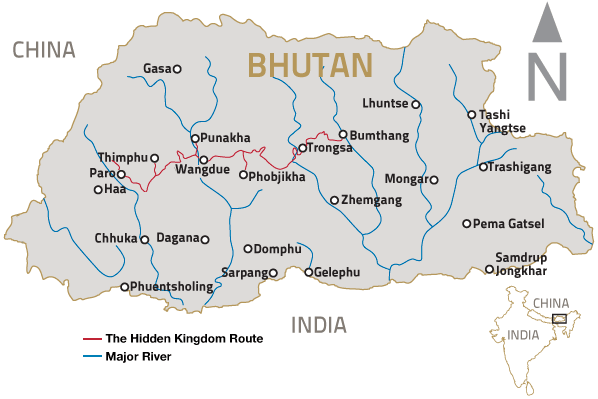
ITINERARY SUMMARY
Day 01: Arrive Paro.
Day 02: Drive to Thimphu.
Day 03: Thimphu.
Day 04: Drive to Punakha.
Day 05: Drive to Trongsa.
Day 06: Drive to Bumthang.
Day 07: Bumthang.
Day 08: Drive to Phobjikha Valley/Gangtey.
Day 09: Drive to Paro.
Day 10: Paro. Hike to Taktsang.
Day 11: Depart Bhutan.
TAILOR-MADE TOUR
Our many years of experience have enabled us to establish the network and knowledge that provide our clients with a more in-depth experience of Bhutan. All of our tours are tailor-designed by our specialist travel designers to ensure they perfectly suit client interests. This itinerary is designed to provide only an example of the kinds of accommodations, activities and experiences that we can customise for you.
INCLUSIONS
- Bhutan Government Tourist Tariff Royalty
- Visa fees
- Arrival & departure airfares to Bhutan including taxes
- Accommodation in superior standard hotels (and premium hotels and resorts where applicable)
- All meals in Bhutan
- Services of a professional, experienced and English speaking personal guide
- Experienced driver
- All private excursions and transfers in superior air-conditioned vehicle.
- All excursions, transfers, route permits and monument fees
NOT INCLUDED
- Medical / Travel Insurance.
- Expenses such as bar and laundry, cigarettes and other tobacco items, sleeping bags whilst on treks and other personal expenses.
- All add-on activities such as wellbeing and spa programs at premium hotels and resorts
- Telephone calls (except those made on the supplied mobile phone for contacting Amulet head office or your private guide)

